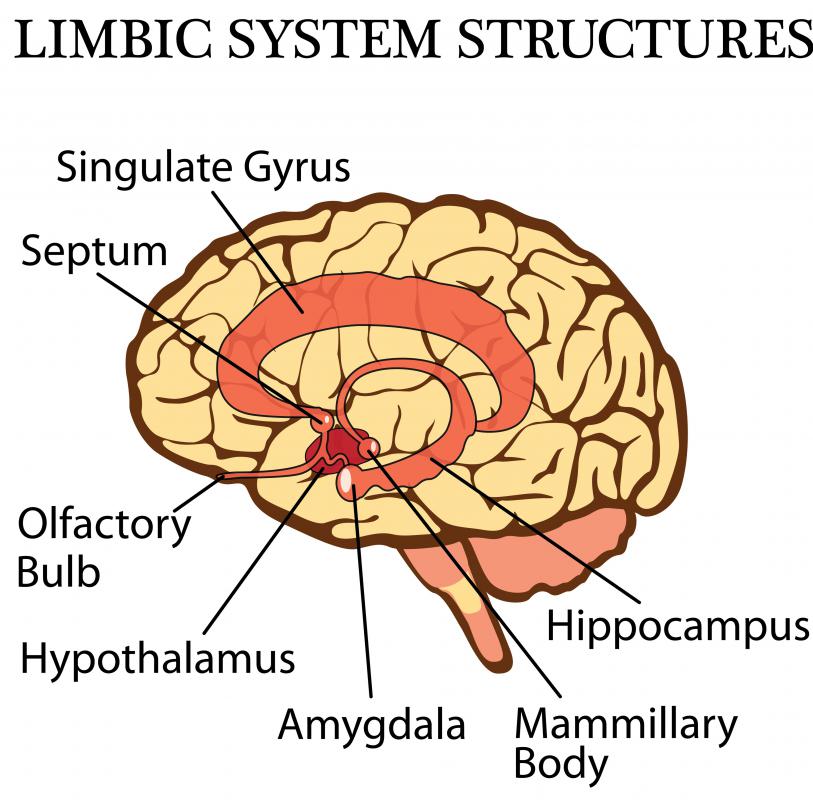At WiseGEEK, we're committed to delivering accurate, trustworthy information. Our expert-authored content is rigorously fact-checked and sourced from credible authorities. Discover how we uphold the highest standards in providing you with reliable knowledge.
What is a Gyrus?
The cerebral cortex, the outer layer of the brain, has many wrinkles. A ridge formed by these wrinkles is called a gyrus. Gyri are surrounded by sulci or fissures, the furrows caused by cerebral wrinkles. Gyri are often used as landmarks to locate certain functional parts of the brain.
The cerebral cortex, both gyri and sulci, is made up of neurons. There are two major types of neurons in this region, projection neurons and interneurons. These neurons are distributed in columns throughout the neocortex, which is about 2 to 4 millimeters thick. The thickness of this area stays constant throughout many species, but the numbers of columns is much larger in more intelligent species. The wrinkled surface of the cerebral cortex drastically increases the brain’s surface area, making room for more columns of neurons.

The wrinkled gray matter of the brain is divided into six layers based on the different types of cells found at different depths. Beneath the gray matter, there is another region made up of white matter. White matter contains the myelinated axons that communicate with other cells.
Moving from the midline of the brain laterally, there are three major gyri on the front part of the cerebral cortex. Most medially located is the superior frontal gyrus. Next to this there is the middle frontal, and then the inferior frontal gyri. These cover a large portion of the surface of the brain’s frontal lobe.

The primary motor cortex, the seat of motor control in the brain, is located on the precentral gyrus, anterior to the central sulcus. This part of the brain communicates with the frontal lobe to plan movements and send signals down to voluntary muscles. On the other side of the central sulcus is the postcentral gyrus, which contains the primary somatosensory cortex. This structure is responsible for receiving and processing sensory information.
The cingulate gyrus, which runs along the side of the brain above the corpus callosum, makes up part of the cingulate cortex. This is considered a separate division of the cortex. It helps make up the limbic system, which is involved in memory, emotion, and learning.
Another important set of gyri is located on the superior temporal gyrus, on the temporal lobe of the brain, somewhere just above the ear. This set of gyri is known as the transverse temporal gyri or Heschl’s gyri. It marks the primary auditory cortex of the brain, which processes auditory stimuli.
AS FEATURED ON:
AS FEATURED ON:












Discussion Comments
@nony - What amazes me is how the brain can adapt. For example, I’ve seen stories on television where people have had some damage to their motor cortex, the area that controls body movements.
Yet, the brain adapted and these people were still able to function some way, although to a lesser extent. I’ve heard that the brain goes through a “rewiring” of sorts, delegating the body movement functions to a different part of the brain.
So that part will pinch hit, so to speak, to take over where the motor cortex was damaged. That’s what amazes me more than how each part of the brain is divided.
I used to see early illustrations of the anatomy of the brain from way back in the Renaissance era. Even though people had the ability to dissect the brain they didn’t have the medical technology nowadays to know what different parts of the brain did.
So you would see the brain diagrammed fairly accurately, with all its ridges and so forth, but scientists were ascribing what they thought were the functions of each part, like the seat of emotions or soul or things like that.
While they were off in their conclusions, at least they knew the different partitions of the brain had to control something. It’s fascinating to realize how precise those functions are.
Post your comments